目录
5 60 本教材点评
5.7 抽象代数 7 本
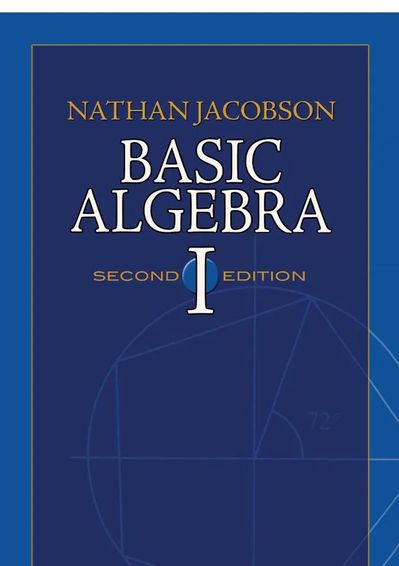
《Basic Algebra Ⅰ》
作者:Nathan Jacobson
出版商:W H Freeman & Co
出版年:1985
ISBN:9780716714804
适用范围:本科生
推荐强度:9
作者简介:Nathan Jacobson(1910-1999),美国科学家,1934年于普林斯顿大学获得博士学位。他曾在多所大学任教研究,最终于1947年开始在耶鲁大学任教直至退休。他是美国国家科学院和美国艺术与科学学院的成员。从1971年到1973年,他担任美国数学学会的主席,并于1998年被授予最高荣誉——Leroy P. Steele终身成就奖。1972年至1974年,他还担任国际数学联合会副主席。
书评(部分包含对Basic Algebra Ⅱ的书评):
It is ironic that two of the most modem texts in abstract algebra, two of the best examples of the power of abstraction, have neither the word modem nor the word abstract in their titles. This modesty signals the beginning of a new style in abstract algebra texts. More than a decade ago, this reviewer lamented the difficulty of teaching to undergraduates from the first edition of Algebra, a book which was the first to depart significantly from the Van der Waerden tradition. The second edition maintains this departure but as a result of reorganization is much more accessible to undergraduates. The first volume of Jacobson's Basic Algebra (BAI) appears to be much more in the Van der Waerden tradition, but has been written so that the nontraditional beginning of Volume II (BAil) is no surprise.
What are the ingredients that mark the departure from tradition? The most striking change is the early use of universal mapping properties in characterizing algebraic objects. Informally, a universal characterization of an object describes a property of the object and then asserts that anything else with the property is related by a morphism to the original object. Typically, the property can be expressed in terms of morphisms as well. Thus, universality is an idea of category theory. (In much the same way that group theory abstracts the study of the automorphisms of a single mathematical object, category theory abstracts the study of homomorphisms among mathematical objects.) As we learn in Algebra, virtually all the familiar algebraic constructionsrings of quotients, homomorphic images, direct products, even the natural number 1-are universal constructions. Chapter 4 of Algebra explains universality in terms of functors to the category of sets. When they are introduced in Chapter 4, categories and functors appear just as natural a part of algebra (and Algebra) as groups and homomorphisms.
Jacobson uses universal characterizations to good effect throughout BAI without stopping to describe how they are all manifestations of the same idea. In Chapter 1 of BAil, he gives us a discussion of category theory that expresses universality in terms of functors between arbitrary categories. The uninitiated reader might not recognize the extent to which universality pervaded BAI from the discussion in BAil, but the reader astute enough to ask the obvious questions will have the reward of being able to answer them. Later chapters of BAil-especially those on modules and homological algebra-make excellent use of the categorical underpinnings from Chapter 1.
A second departure from tradition of these texts is the introduction of ideas from universal algebra. In universal algebra, we study algebraic systems (sets with operations defined on them) in general rather than concentrating on a particular system. We study concepts such as homomorphisms, product constructions, subal~ebras, etc., that can apply to all these systems. Further, we study families of algebras satisfying certain axioms; if these happen to be the axioms of a familiar system such as a group, then we are studying properties that distinguish that system from others. In Algebra the principal ideas from universal algebra are the almost traditional lattice theoretic ideas. Lattices are used primarily as an interesting algebraic system rather than being applied to the study of other algebraic systems. In BAil, however, Chapter II is almost a course in universal algebra, covering the basic isomorphism theorems, direct and inverse limit constructions, free algebras and varieties of al~ebras. fhese topics do not play a heavy role in the remainder of the volume; this is more a testimony on the lack of influence of universal algebra on recent developments in core algebra than it is a criticism of the text. What is unfortunate is that neither text adopts from universal algebra the appealing idea of the equivalence of morphisms and congruence relations-a congruence relation for an operation like group composition preserves that operation in the same way that congruence modulo n preserves addition and multiplication. This idea ties together all the basic homomorphism theorems of groups, rings, vector spaces, etc., as manifestations of a common idea, and, for example, makes it natural that only normal subgroups appear in the homomorphism theory of groups while all subspaces appear in the homomorphism theory of vector spaces (and no sublattice of a lattice plays the role of the kernel of a homomorphism). The fact that virtually all our familiar algebraic systems are special cases of monoids is clear in both books; this point of view is certainly in harmony with universal algebra.
In both texts, ideas involving linearity are discussed for modules over rings rather than vector spaces over fields. This aids our real understanding of these ideas by showing what properties of the rings are actually used at each stage of development. Even better, ideas from different areas of the traditional organization appear as corollaries of the same idea. For example, in Algebra determinants and tensor products live together and appear later with exterior algebras (an even more natural marriage than determinants and tensors). In BAI, determinants appear with exterior algebras. In both, the theories of finite abelian groups and the rational canonical form cohabitate.
Algebra follows one tradition from the Birkhoff and Mac Lane Survey Series, namely linear algebra's role is more predominant than in other texts. Perhaps 40% of the book consists of topics we would normally associate with linear and multilinear algebra. This book is well suited to give all the advanced training in algebra an undergraduate needs. In fact, as one who teaches graduate courses in combinatorics using topics from widely separated branches of algebra, I would be delighted if my graduate students had mastered the concepts in Algebra.
In its two volumes, Basic Algebra comprises an entire education, advanced undergraduate and graduate, in algebra, an education deep enough to serve as a springboard to research in most traditional areas of algebra. It is unlikely that many graduate students, even those specializing in algebra, have learned such a breadth of ideas in such depth. To my knowledge, only Bourbaki has attempted as deep a survey of algebra as appears in BAil. (Of course in their encyclopedic way, the Bourbaki group covers even more.) Though linear and multilinear algebra is woven throughout BAI and BAil, it does not play as prominent a role in Basic Algebra as in Algebra. With that exception, BAil takes us on a tour of core algebra including commutative algebra, the structure theory of rings and algebras, representation theory for groups, and field theory in addition to its category theory, universal algebra and homological algebra. (Homological algebra, which arose from work on chains and cochains in algebraic topology, is based on the study of sequences of modules connected by homorphisms. Homological algebra has provided proofs of results of algebraic interest, some appearing in BAil, as well as results of topological interest. In the guise of exact sequences, it has had an influence on Algebra as well.)
Of course, it is unfair to expect a textbook to contain a complete compendium of results; however, I admit to disappointment that after developing the machinery needed to prove the unique factorization theorem for regular local rings, BAil does not include it even as a series of exercises. To a lesser extent, I felt a similar unsatisfied feeling when the results on modular and distributive lattices were not used in the appropriate places in ring theory (for example, a Dedekind domain is a domain whose lattice of ideals is distributive, and the modularity of the lattice of submodules of a module has not been exploited). When defining a coalgebra, Professor Jacobson comments that It is nice to have a pretty definition, but it is even nicer to have some pretty examples. His examples are undeniably pretty, but in neither one do we learn what makes the coalgebra structure of interest. Frequently, the examples leave something to our imagination in this way. Since there is a tradeoff between the amount covered and the details included in a book, we should not regard the rather telegraphic style of examples in BAil as a defect. However, even the experienced mathematician can profit from discussions of BAil with a more knowledgeable colleague.
What role can these books play in a college mathematics curriculum? Both Algebra and BAI are appropriate for a one or two semester course in abstract algebra. If this were an undergraduate course, I'd want to restrict enrollment to honors students, successful mathematics students who are motivated by a genuine interest in mathematics. I would also be much more comfortable if the students had had a linear algebra course-a highly geometric version of the sophomore level course offered by many institutions would be totally appropriate, and would make the student's relationship with Algebra especially rewarding. With a strict selection of topics (omitting entire chapters), Basic Algebra I seems ideally suited for a two semester or three quarter course which would cover all the standard topics (including Galois theory) in the groups-rings-fields-vector spaces tradition. However, separate study in linear algebra would be essential to fill out the traditional program. Algebra would shine in a three semester sequence. Again, the sequence would cover all the traditional topics (Galois theory is in the second edition of Algebra and was not in the first) but would also provide an advanced linear and multilinear algebra background and touch gently on categories. As undergraduate texts, both lack a sufficient variety of straightforward exercises to give students practice with routine techniques. Both also expect the reader to think about the examples rather than merely digest them. At times the attention to detail in Basic Algebra obscures the idea behind a proof. Thus an instructor using one of these books will still have some work to do.
For graduate students, one might use portions of BAI in a one semester course or use Algebra in a two semester course. Either of these courses could be profitably followed by a course from BAil. How long would the course last? As long as possible! Realistically, there are at least four semesters worth of work in BAil. This volume is Professor Jacobson's gift to those of us who use algebra; I believe that as many mathematicians as possible should be exposed to as much of it as possible.
The authors of two of the most successful traditional series in abstract algebra have given us books with a fresh and much more modern perspective in algebra. We know now how algebra should be taught in the future.
讽刺的是,作为最现代化,最能体现抽象能力的抽象代数教材,它们的书名中既没有“现代”,也没有“抽象”。而它们也确实引领了抽象代数教材编写的新风潮。十几年前,用Algebra的第一版作为抽象代数教材的教师曾感叹于其对于本科生过于晦涩难懂,这本书也是第一本与Van der Waerden传统教材有极大不同的代数学教材。Algebra的第二版保留了与Van der Waerden想法的分歧,同时也更适于本科生学习。Jacobson的Basic Algebra的第一卷(BAI)似乎要更接近Van der Waerden的传统思想,但第二卷(BAII)开始却也与Van der Waerden的思想相去甚远。
这种对传统的背离有何体现?最显著的特点是在描述代数对象时,早早地使用了泛映射性质。通俗地说,泛性先描述一个代数对象的性质,再断言所有具有相同性质的代数对象都与最初的代数对象通过态相关。一般地,这种性质也能用态的方式表出。因此,泛性是范畴论的一种思想(就像群论将单一数学对象的自同构抽象化一样,范畴论将数学对象间的同态抽象化)。正如我们在Algebra中所学的那样,几乎所有常见的代数结构,商环、同态像、直积甚至自然数1都是泛结构。Algebra的第四章用集范畴的函子来解释泛性。对代数学来说,引入范畴与函子是十分自然的,就像引入群与同态那样。
Jacobson在整本BAI中使用泛性,很好地描述了这些代数结构都是同一思想的不同表现。在BAII的第一章中,他讨论了范畴论中通过任意范畴间的函子来表示泛性的方式。
缺少经验的读者可能无法认识到为何BAI与BAII中处处渗透着泛性的思想,而足够机敏来提出这一问题的读者,也能从探寻答案中学到许多。BAII的最后一章,特别是模与同调代数的部分,很好地使用了第一章的范畴论知识。
这些教材与传统教材的第二个不同是介绍了泛代数中的思想。在泛代数中,我们学习代数系统(集合与定义在其上的运算)整体,而不聚焦于某个特别的系统。我们学习那些可以应用于所有系统的概念,例如同态、积结构、子代数等等。更一般地,我们学习满足特定公理的代数族;如果它们恰好是某一常见系统的公理,例如群,那么我们就研究其独有的性质。在Algebra中泛代数的思想与传统代数中格理论的思想类似。格作为一种十分有趣的代数系统,很少应用于其他代数系统的研究。然而在BAII中,第二章几乎全部是泛代数的内容,包括了基本同构定理,正向和逆向极限,自由代数与代数簇。这些内容在本书的剩余部分中并不是那么重要;与其说这是本书的缺点,不如说印证了泛代数对代数学最新研究的影响有所不足。不幸的是,这两本教材都没有采用泛代数中有关态的等价和同余关系的一个十分吸引人的思想——关于抽象运算的同余关系,如同群合成保运算,或是自然数模n同余保加法与乘法那样。这一思想把群、环、向量空间等等对象的基本同态定理联系在一起,使它们成为同一思想的不同表现形式。举个例子,使下面这一结论变得十分自然:只有正规子群可能成为群同态的核,而所有子空间却都有可能成为向量空间同态的核(再者,不存在子格使它同时是一个格同态的核)。事实上,我们所熟悉的所有代数系统都是幺半群的特例,两本教材都清晰地表达了这点,这与泛代数的观点是一致的。
两本书中,有关线性的讨论都是基于环上的模而非域上的线性空间。这有助于我们理解在形成线性结构的过程中哪些性质被真正地使用。更巧妙的是,来自传统代数学的不同思想成为了同一思想的推论。举个例子,在Algebra中,行列式与张量积形影相随,并且之后与外代数(一种比行列式和张量积更自然的概念)一同出现。在BAI中,行列式与外代数一同出现。无论哪本书中,有限Abel群理论都与有理标准型共存共生。
Algebra延续了相同作者A Survey of Modern Algebra一书中一个观点,比其他教材更注重线性代数的部分。大概全书40%的内容都与线性和多线性代数有关。本书非常适合本科生来体会更高层次的代数思想。实际上,作为一名教授组合学课程的教授,如果我的学生掌握了Algebra中的概念,我会非常高兴的。
而两卷Basic Algebra则是一套面向高年级本科生与研究生的完整代数学教程,也是一套足够深入的教材,可以以此为跳板来研究传统代数学中的绝大多数问题。许多研究生,甚至是那些专攻代数学的研究生,都不太可能在如此深度上学到如此广博的知识与思想。据我所知,只有Bourbaki学派尝试过像BAII那样深入研究代数学(当然,因它们百科全书的方式,Bourbaki学派的教材涵盖得更广)。虽然线性与多线性代数贯穿BAI与BAII,但它的篇幅却逊于Algebra中的相同内容。除此之外,BAII带领我们周游了整个代数学国度,除了范畴论,泛代数与同调代数(同调代数,兴起于代数拓扑中链和上链的工作,基于由同态相连的模序列。同调代数给出了代数学和拓扑学中许多结果的证明,部分在BAII中被提及),还包括交换代数,环与代数的结构理论,群表示论和域论。
当然,希望一本教科书面面俱到是不现实的。然而令我失望的是,在正则局部环唯一分解定理的相关证明方法发展后,BAII并未包含相关内容,甚至没有把它编入习题。此外,当模格和分配格的相关结论并未在环论中的恰当位置被使用时,我也有些不满(例如,一个Dedekind域是一个理想格是分配格的域,而且并未用到模的子模格的模性质)。在定义余代数时,Jacobson认为有一个漂亮的定义很好,但有一些漂亮的例子会更好。这些例子的确很漂亮,但我们却并不能得知是什么引起了人们对余代数的兴趣,它们常以这种方式留给读者想象的空间。既然一本书所包含内容的广度与叙述的细致程度之间有一种平衡,那么我们就不应将这种不断给出例子的方式看作缺点。然而即使经验丰富的数学家,也能在和同事讨论BAII中获益良多。
这些书能在大学数学课程中起到什么作用呢?Algebra与BAI都适用于一或两学期的抽象代数课程。如果这是一门本科课程,我会只招收荣誉学生,即那些对数学有真正兴趣的学生。如果学生们上过线性代数课程,我也会感到舒服得多——许多学院提供的大二水平的偏重几何的课程十分合适,并且会使学生学习Algebra时更得心应手。在对内容的严选下(省略一些章节)BAI似乎非常适合两学期的课程,涵盖群、环、域、向量空间的基础内容(包括Galois理论)。然而对传统的学习模式来说,线性代数是必不可少的部分。Algebra非常适合三学期的课程。同样,这将涵盖所有基本内容(只有第二版Algebra才包含Galois理论相关内容),但会额外提供一些线性与多线性代数的背景和范畴论的初步知识。作为本科生教材,它们都缺乏足够习题以供学生来练习常规技巧。两本教材都希望读者思考这些例子,而不仅仅是了解。有时,Basic Algebra中对细节的关注掩盖了证明背后的思想。因此,教师在使用它们时仍有一些工作要做。
对于研究生来说,可以在一个学期的课程中用BAI的一部分,或者在两个学期的课程中使用Algebra, 并在接下来学习BAII。课程要持续多久?尽可能长!实际上,学习BAII至少需要四个学期。这本书是Jacobson教授送给代数学研习者的礼物;我相信尽可能多的数学家应该尽可能多地接触代数学。
两个最成功的抽象代数系列教材的作者给了我们一个全新的、更现代的代数视角。我们现在知道将来代数应该怎么教了。
点评人:Kenneth Bogart(美国数学家,达特茅斯学院教授,著有Introductory Combinatoric)
资料整理:孟文斌
翻译:赵旭彤
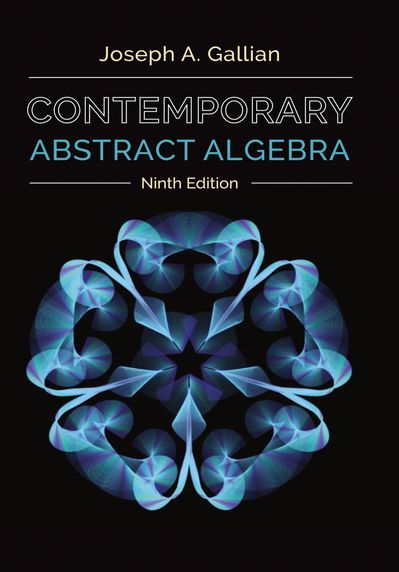
《Contemporary Abstract Algebra》
作者:Joseph Gallian
出版商:Cengage Learning
出版年:2016
ISBN:9781305657960
适用范围:本科生
推荐强度:8
作者简介:Joseph Gallian(1942-),美国数学家,莫尔斯大学杰出校友教授,任教于明尼苏达大学德卢斯分校数学和统计学系。Gallian获得了美国数学协会(MAA)的Allendoerfer奖和Evans奖,并在1999年至2001年担任MAA的Polya讲师。
书评:
Before I delve into an analysis of this excellent textbook, let me highlight first that abstract algebra, contrary to much uniformed opinion, is not a specialistic, esoteric field in pure mathematics characterized by very limited applicability to the physical world. On the contrary, this subject is not just extremely beautiful, but a very important and even foundational discipline in many areas of mathematics and science.
In fact, structure and symmetry are a fundamental aspect of physical reality. It might well be argued that science is nothing but the discovery of symmetries, patterns and structures that define reality at its most fundamental level.
There is for example a natural connection between particle physics and representation theory of abstract algebra, linking the properties of elementary particles to the structure of Lie Groups and Lie Algebras (in particular, the different quantum states of any given elementary particle corresponds to an irreducible representation of the Poincare' group). Poincare' invariance is the fundamental symmetry in particle physics: a relativistic quantum field theory must have a Poincare'-invariant action (one of the most important example of a symmetry in physics is that the speed of light has the same value in all frames of reference, which is represented by the Poincare Group, the symmetry group of special relativity).
We should also not forget that, while the spacetime symmetries represented by the the Poincare' group are the first that come to mind and the easiest to conceptualize, the physical world is also defined by many other types of symmetries, not least some internal symmetries such as the “color” symmetry SU(3) (the symmetry corresponding to the continuous interchange of the three quark “colors” responsible for the strong force). Moreover, a gauge U(2) × U(1) theory fully explains the unified electro-weak interactions (the requirement that a theory be invariant under local gauge transformations involving the phase of the wave function ultimately brought to the positing of the laws underpinning the interaction of light and matter - indeed, in quantum mechanics, gauge symmetry can be seen as the basis for electromagnetism and conservation of charge).
In more general term, local symmetries play a fundamental role in physics as they form the basis for gauge theories (a gauge theory is essentially a type of field theory in which the Lagrangian is invariant under some Lie groups of local transformations).
It is also important to highlight that symmetry in general is fundamental in the physical world: as an example charge, parity, and time reversal symmetries (CPT) are fundamental symmetries in the Standard Model, whose transformations are symmetric under the simultaneous operation of charge conjugation (C), parity transformation (P), and time reversal (T).
Going beyond the realm of fundamental physics, molecular symmetry is a fundamental concept in chemistry, as it can predict or explain many of a molecule's chemical properties such as its dipole moment. In the biological sciences, I was told (my personal knowledge of the biological sciences is pretty rudimentary) that symmetry and symmetry breaking play a prominent role in developmental biology, from bilaterians to radially symmetric organisms (see for example https://tbiomed.biomedcentral.com/art...).
Moreover, group theory has many applications in cryptography, robotics and computer vision, just as another example of concrete application of abstract algebra concepts.
Abstract algebra is therefore extremely important and foundational in many fields, and not just in pure mathematics: it provides a set of powerful technical and conceptual tools that allow abstraction of apparently complex systems in such a way as to allow a rigorous mathematical treatment of some of their fundamental and defining features (symmetries and patterns) through the usage of algebraic structures such as groups, rings, vector spaces, algebras and fields. Adding hours on a clock, for example, is like working in a cyclic group; many manufacturing processes might be shown to be isomorphic to products of permutations of a finite group; and group theory and abstract algebra applied to molecular systems biology support the design of new drugs. In general, abstract algebra (and group theory in particular) provides a framework for constructing analogies or models from abstractions, and for the manipulation of those abstractions to design new systems, make predictions and posit new hypotheses.
OK, now that justice has been rendered to this fascinating and beautiful subject, the time has finally come for me to review this informative University textbook, which represents a very good introductory treatment of the fundamental elements of abstract algebra (group theory, rings, fields) at a level which is typically addressed at senior Mathematics undergraduate stage.
This book is very accurate and nicely written, with very few typos (all of them minor), a very good choice and variety of relevant exercises at different level of complexity (the majority of them are actually pretty easy), with minimal and only occasional hand-waving; it is also a book rich with examples (a critical feature in a subject that sometimes can sorely test the abstract thinking capabilities of even the keenest reader), and presenting a tightly organized and generally reader-friendly progression of concepts and techniques. I also greatly appreciated the full list of notational conventions at the beginning of the book, and the list of suggested readings at the end of each chapter.
On the not-so-positive side, I must said that I would have preferred way more depth and detail in some areas such as symmetry groups, that the proofs of some theorems are a bit too terse (leaving conceptual and computational gaps that require a bit of effort to fill), and that too few examples of practical applications are presented, occasionally giving the book a very “abstract” feeling. I must also point out, though, that this book contains one of the best treatments of factor groups, the Lagrange theorem, the Sylow theorems and the fundamental theorem of finite abelian groups that I have come across so far.
In summary, my general experience with this book has been quite a positive one; independently of the quality of this particular book, I must also say that studying abstract algebra has been for me a rewarding intellectual journey (I did study some abstract algebra at university, but it was only at introductory level and manly focused on vector spaces), as it is very remarkable how, by starting just with the basic definition of an extremely simple concept such as that of a group, whole worlds of progressively richer and more complex structures, patterns and relationships are progressively unveiled in a process of enthralling discovery.
Overall, this is a 4-star book. Not a perfect book by any means, and possibly too basic in some areas, but a solid good textbook recommended to anybody interested in a treatment of this fascinating subject delivered, with a good pedagogical approach, at senior undergraduate level.
在我深入分析这本优秀的教科书之前,让我先对抽象代数做一些解释,不同于许多人,我不认为它是基础数学中一个很难直接应用于物理世界的,独立而深奥的领域。相反,这门学科不仅非常美丽,而且在数学和科学的许多领域中都是一门非常重要甚至是基础性的学科。
事实上,物理现实中处处存在着各种形式的结构与对称。科学只不过是在最基本的层面上发现并定义现实中的对称性、模式和结构。例如,粒子物理学和抽象代数中的表示论之间有一种天然的联系,即基本粒子的性质与Lie群和Lie代数的结构间的联系(特别地,任何给定的基本粒子的不同量子态对应于Poincare群的不可约表示)。Poincare不变性是粒子物理学中基本的对称性:量子场论中的研究对象必须具有Poincare不变性(物理学中对称性的最重要例子之一是,光速在所有参照系中都具有相同的值,这个值由狭义相对论的对称群,即Poincare群表示)。
我们也不应该忘记,尽管Poincare群所代表的时空对称性是最先被想到的,也是最容易概念化的,但物理世界也被许多其他类型的对称性所定义,尤其是一些内部对称性,例如“颜色”对称SU(3)(对称性对应于负责产生强力的三个夸克“颜色”的连续交换)。此外,U(2) × U(1) 规范理论充分解释了统一的电-弱相互作用(要求理论在包含波函数相位的局部规范变换下是不变的,最终导致了支撑光与物质相互作用的定律的确定,在量子力学中,规范对称性可以被看作是电磁学和电荷守恒的基础)。
更一般地说,局部对称性在物理学中发挥着基础性的作用,因为它们构成了规范理论的基础(规范理论本质上是一种场论,其中Lagrange函数在一些局部变换李群下是不变的)。
同样重要的是强调对称性在物理世界中是基本的:例如电荷正负对称、宇称对称、时间反演对称(CPT)是标准模型中的最基本的对称性,在电荷共轭(C)、宇称变换(P)和时间反转(T)的同时运算下,它们的变换是对称的。
除了基础物理领域,分子对称性也是化学中的一个基本概念,因为它可以预测或解释分子的许多化学性质,如它的偶极矩。在生物科学领域,有人告诉我(我个人对生物科学了解很少),从双侧对称到辐射对称的有机体,对称性和非对称性在现代生物学中起着重要的作用。
此外,群论在密码学、机器人学和计算机视觉领域也有很多应用,就像抽象代数概念的其他应用实例一样。
因此,抽象代数在许多领域都是极其重要和基础性的,不仅仅是在基础数学领域:它提供了一套包含技巧与概念的强大理论工具,允许将表面上复杂的系统抽象化,通过使用像群、环、向量空间、代数与域之类的代数结构,来对它们的一些基本特征(对称性和结构)进行严格的数学化处理。例如,时钟指针的转动就像循环群;许多制造过程可能同构于一个有限群的置换的乘积; 应用于分子生物学的群论和抽象代数理论支持着新药的设计。一般来说,抽象代数理论(特别是群论)提供了一个框架,用于将实际抽象化为模型,并利用这些抽象模型来设计新的系统,做出预测与假设。
好了,现在这个迷人而美丽的学科已经得到了公正的对待,现在终于到了我复习这本内容丰富的大学教材的时候了,它很好地在高年级本科生的水平上介绍了抽象代数的基本内容(群、环、域)。
这本书写得非常准确和漂亮,几乎没有印刷错误,难度各异的习题选取恰当(实际上,其中大部分非常简单),只有小部分棘手的题目; 它还是一本有丰富例子的书(这对于抽象代数而言很关键,因为有些内容十分考验读者的抽象思维能力,即使是那些高水平的读者),使抽象代数的概念与技巧不仅组织严密,同时相对通俗易懂。我也非常欣赏本书开头列出全部符号,以及每章结尾列出建议阅读书目的习惯。
对于这本书的缺点,我必须说在某些领域我希望看到更详细深入的内容,比如对称群。一些定理的证明过于简洁(无论是计算上还是概念上都存在不直接的步骤),例子与实际应用过少,偶尔让这本书给人一种非常“抽象”的感觉。不过我也必须指出,这本书所处理商群,Lagrange定理,Sylow定理和有限Abel群的基本定理的方法,都是迄今为止我遇到过最好的处理方法之一。
总而言之,这本书给我以相当好的体验;撇开书的质量不谈,我还必须说,学习抽象代数对我来说是一次收益颇丰的智力之旅(我在大学的时候确实学过一些抽象代数,但那只是入门,并且只专注于向量空间),同时它也十分令人难忘,仅仅从一个极其简单的概念(例如群)的基本定义开始,整个世界的结构、模式和关系逐渐丰富,在探索的过程中逐渐被揭开。
总的来说,这是一本四星级的书。无论如何都不是一本完美的书,而且在某些领域可能过于基础,但如果教学方法正确,它就是一本可靠的教科书,适合那些对抽象代数感兴趣的高年级本科生。
点评: Goodreads书评
资料整理:孟文斌
翻译:赵旭彤
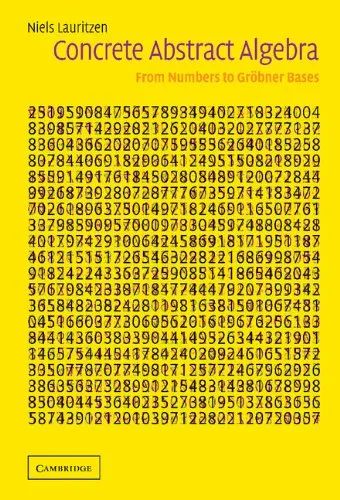
《Concrete Abstract Algebra: From Numbers to Gröbner Bases》
作者:Niels Lauritzen
出版商:Cambridge University Press
出版年:2003
ISBN:9780521826792
适用范围:本科生
推荐强度:9
作者简介:Niels Lauritzen,美国数学家,1993年于伊利诺伊大学香槟分校获得博士学位,现任奥尔胡斯大学副教授,主要研究领域有计算机科学和数学、代数几何。
书评:
“The present book provides a first introduction to some of the most fundamental concepts, methods and results of abstract algebra. Based on several years of experienced teaching at the University of Aarhus, Denmark, it offers most of the usual material of a traditional, one-semester introductory course on the basics of elementary number theory and algebraic structures, with the exception of field extensions and elementary Galois theory. Actually, this alone would not essentially distinguish the text from many others with the same basic goal. However, the book under review has its own special flavor. In fact, as the title already tries to indicate, the concrete aspects of the abstract material are strongly emphasized. Namely, the author’s didactic philosophy underlying this book is that gripping applications and examples help to incite motivation and ease the understanding of the various abstract concepts. Thus, instead of trying to cover as much abstract theory as possible in such an introductory course, he preferred to combine a little less of abstract material with a rich supply of illustrating, inspiring and modern applications such as cryptography, factoring algorithms for integers and polynomials, Gröbner bases for ideals of polynomials in several variables, and solving systems of nonlinear polynomial equations effectively. These applied topics are usually not found in most primers of this kind, at least not at the undergraduate level and in such a general context, but the author’s teaching experience has taught him that especially their taking in has improved student performance in this course significantly. Thus it seems to be worth for both teachers and students to attempt this interesting approach to basic abstract algebra, and leave the other traditional topics (such as general fields and Galois theory) for a subsequent course in algebra. Also, this approach is far from being just a populist’s compromise in order to please students. On the contrary, it rather appears to be timely, purposeful and serviceable.
As to the precise contents, the text consists of five chapters and two appendices. Each chapter is subdivided into about ten sections and comes with a set of approximately fifty exercises at the end. Chapter 1 has been given the title “Numbers” and explains the elementary structure theory of the integers, including divisibility, linear congruences, prime numbers, and Euler’s φφ-function. The applications and examples in this introductory chapter concern the RSA cryptosystem, the finding of big prime numbers, primality tests, and algorithms for prime factorization. These topics fit perfectly in our modern information age, thereby demonstrating the importance and ubiquity of elementary number theory, even without abstact algebra yet. This chapter concludes with quadratic residues, Euler’s theorem, and a first discussion of the Gaussian law of quadratic reciprocity.
Chapter 2 treats elementary group theory up to the Sylow theorems, with elementary number theory revisited and re-interpreted. Symmetric and alternating groups, together with their concrete applications, are particularly emphasized, and Sam Loyd’s classical 15-puzzle (1878) serves as a just as striking as entertaining application of a special kind.
Chapter 3 turns to rings, with the main focus on commutative rings and their ideals. The dominating topic of this chapter, namely the structure of unique factorization domains, is again put in the context of the integers and their elementary number theory, including Fermat’s two-square theorem as well as a brief survey of the history of Fermat’s last theorem.
Chapter 4 is then devoted to the theory of polynomial rings (over a ring) in one variable. The main topics discussed here are: cyclotomic polynomials, primitive roots and public key cryptography, a ring-theoretic proof of the law of quadratic reciprocity, finite fields, and the Berlekamp algorithm for factoring polynomials over a finite field.
Further illustrations concern the ElGamal cryptosystem and the infinitude of prime numbers congruent to one modulo a natural number. Chapter 5 stresses the particular role of polynomial algebra in this textbook, and it culminates in one of the above-mentioned peculiarities of this primer in abstract algebra which is: Gröbner bases of polynomial ideals and their applications. After introducing polynomial rings in several variables, the author explains the more recent concept of Gröbner bases for polynomial ideals, together with their computational aspects and algorithmic properties.The reader will see, among other things, proofs of the classical Dickson’s lemma and Hilbert’s basis theorem (using Gröbner bases), an algorithm for expressing symmetric polynomials, Buchberger’s SS-polynomials and algorithm for constructing Gröbner bases, numerous explicit examples with them and – as a concluding highlight – how to solve systems of polynomial equations using Gröbner bases.
Appendix A briefly resumes some basic set theory, in particular equivalence relations, and the construction of the integers and the rational numbers. Appendix B recalls some basic linear algebra (with proofs) as needed in the text.
The entire book is larded with a wealth of concrete examples, additional remarks related to the respective matter, historical annotations or anecdotes, and bibliographical hints for further reading. The numerous, carefully selected exercises to each chapter reveal the author’s apparent teaching experience. These exercises vary in their degree of difficulty and challenge, and some of them are indicated as a test of student ingenuity. Nevertheless, this textbook is absolutely self-contained, with the prerequisites kept to a minimum. The exposition is perfectly lucid, rigorous, detailed and user-friendly, which makes the book also suitable for private study.
In summary, this is a highly interesting and original textbook on basic abstract algebra, with many topical extras and didactic novelties. It is perfectly suited for beginners in the field and reflects very much the spirit of our modern age. Being of such a kind, this primer of abstract algebra is highly recommendable for both students and teachers. As for further reading on a higher and more sophisticated level, we would like to recommend the related and just as recent textbook by Sabah Al Fakir, entitled “Algèbre et théorie des nombres – cryptographie, primalité (Ellipses Édition, Paris 2003).”
本书首先介绍了抽象代数的一些最基本的概念、方法和结论。基于在丹麦奥尔胡斯大学几年的经验教学,作者提供了供一学期讲授的内容,除域扩张与Galois理论外,几乎包括所有传统代数学基础知识。实际上,仅仅这一点并不能从本质上将该教材与许多其他具有相同基本目标的教材区分开来。然而,本书也有其独特的韵味。事实上,正如标题所述,本书更加强调抽象代数中不那么抽象的部分。换句话说,作者编写这本书时的想法是,有趣的应用和例子有助于了解为什么要学习抽象代数,以及加深对各种抽象概念的理解。因此,在这样一个入门课程中,他没有试图尽可能多地介绍抽象的理论,而是倾向于将少量抽象概念与丰富的说明、联想与现代应用结合起来,如密码学、整数和多项式分解算法、多元多项式理想的 Gröbner 基以及如何有效地求解非线性多项式方程组。在大多数入门教材中通常找不到这些关于实际应用的内容,至少在本科阶段的教材中一般找不到,但作者的教学经验告诉他,学习这些内容显著地提高了学生在这门课程中的成绩。因此,对于老师和学生来说,尝试用这种有趣的方法来学习基础抽象代数是值得的,至于其他传统抽象代数涉及的内容(如域论和Galois理论)则被留至后续的代数课程中。此外,这种方法绝不仅仅是为了取悦学生而进行的妥协。相反,它既有自身的目的,也体现了其效用。
至于具体内容,全文共分五章和两个附录。每一章被细分为大约10个小节,并在最后附有大约五十道习题。第一章给出了整数的基本结构理论,包括整除、线性同余、素数和Euler函数。本章介绍的应用和例子涉及到 RSA 密码系统,大素数的发现,验证一个数是否是素数,以及分解质因数的算法。这些内容契合现代信息时代,从而证明了初等数论的重要性,即使还未涉及抽象代数。本章最后介绍了二次同余、Euler定理以及二次互反律。
第二章讨论初等群论的内容,直至Sylow定理,并对其以初等数论重新审视和重新解释。对称群与交错群以及它们的具体应用被特别强调,而 Sam Loyd 的经典15字谜(1878)作为一种有趣应用,也同样引人注目。
第三章介绍环,主要讨论交换环及其理想。本章的主题,即唯一分解整环的结构,再次被放在整数与初等数论的背景下加以介绍,包括对Fermat平方和定理与Fermat大定理的简要介绍。
第四章讨论了一元多项式环的理论。这里讨论的主要课题有: 分圆多项式、本原根和公钥密码学、二次互反律的环论证明、有限域以及有限域上多项式因式分解的 Berlekamp 算法。进一步的例子涉及 ElGamal 密码体制和存在无穷个素数的命题。
第5章强调了多项式代数在这本教科书中的特殊作用,并归结为这本抽象代数教材的一个与众不同的地方: 多项式理想的Gröbner基及其应用。在引入多元多项式环之后,作者解释了多项式理想的Gröbner基的概念,以及它们的计算方法和性质。除此之外,读者将看到经典的Dickson引理和Hilbert基本定理的证明(使用Gröbner基)、表示对称多项式的算法、Buchberger的 SS多项式和构造Gröbner基的算法、用它们构造的大量具体例子以及——作为结束的亮点——如何使用Gröbner基解多项式方程组。
附录A简要介绍了一些基本的集合论,特别是等价关系,以及整数和有理数的构造。附录B回顾了教材中需要的一些基本线性代数知识(包括证明)。
整本书里有大量具体的例子,与内容相关的附加评论,历史性的注释或轶事,以及参考文献,以供读者进一步阅读。每一章都有大量经过精心挑选的习题,体现了作者丰富的教学经验。这些习题的难度各不相同,其中一些更多地考察读者的创造力。然而,这本教科书却已足够完整,对预备知识的要求只有最低限度。本书论述完美清晰,严谨详细,对读者十分友好,这使得该书也适合个人学习参考。总而言之,这是一本非常有趣的基础抽象代数教科书,包含许多富有话题性的附加内容和新颖的教学方法。它非常适合此领域的初学者,并体现了很多现代方法。既然如此,这本抽象代数的入门教材对学生和老师来说都是非常值得推荐的。
点评人:Werner Kleinert (柏林洪堡大学数学研究所)
资料整理:孟文斌
翻译:赵旭彤
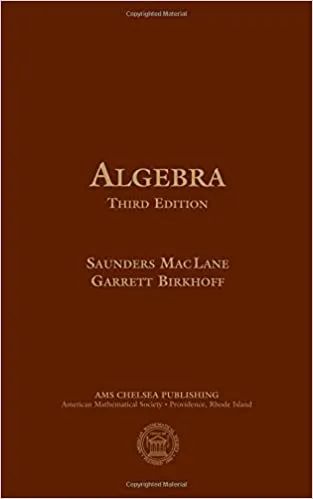
《Algebra》
作者:Saunders Mac Lane; Garrett Birkhoff
出版商:American Mathematical Society
出版年:1999
ISBN:9780821816462
适用范围:本科生
推荐强度:9
作者简介:Saunders Mac Lane(1909-2005),美国数学家。Mac Lane于1945年与Samuel Eilenberg共同创立了范畴论,他尤其以在相干定理方面的工作而闻名。Mac Lane是美国国家科学院和美国哲学学会的副主席,也是美国数学学会的主席。于1949年入选美国国家科学院,并于1989年获得国家科学奖章。
Garrett Birkhoff(1911-1996),美国数学家,他的父亲同是著名数学家George Birkhoff (1884–1944),而他最著名的研究是晶格理论。Birkhoff发表了200多篇论文,指导了50多名博士。他是美国国家科学院和美国艺术与科学学院的成员。1948年至1949年,他是古根汉姆大学的研究员;1966年至1968年,他是工业和应用数学学会的总统会员。1974年,他获得了莱斯特·福特奖。
书评:
Nearly any ten years there seems to arrive a new edition of this now classical book the review of which (1st edition 1967; Zbl 0153.324, 2nd edition 1979; Zbl 0428.00002) the reviewer hardly can improve. The main advantage of the authors had been the introduction of thoroughly categorical concepts into algebra. Nowadays nobody wonders at this but perhaps at “universal constructions” which have faded out. On the other side, the concept of a group acting on a set, which is essential, e.g. for Galois theory, is not equally clearly worked out, not even in categorical terms. I also miss ‘normal bases’ in the index (not only there!), and ‘finite fields’ only cover two pages. As an annex the authors attend a chapter on affine and projective geome extensions of the residue fields, the pair (S1,L1(I)) is independent of the generating sequence f and is defined to be the first universal link of I. By iterating this process i times one gets the i-th universal link (Si,Li(I)). The ideal Li(I) is linked to ISi in i steps.
The significance of the above construction lies in the following result proved in the cited paper: If R/I is Cohen-Macaulay and Ii is an ideal linked to I in i steps then the pair (Si,Li(I)) is essentially a deformation of the pair (R,Ii). This means that there exists a pair (T,J) which can be obtained from each of (Si,Li(I)) and (R,Ii) by a finite succession of the following operations: deformation, localization, purely transcendental extension of the residue field. Further, if i is even then (Si,Li(I)) is essentially a deformation of (R,I).
The technique of universal linkage described above is applied to obtain various results on the structure of licci ideals and, in particular, to describe for R/I (R regular, I licci) the singular (resp. Gorenstein) locus and the divisor class group and some interrelations among these.
这本经典的教材几乎每十年就会推出新的版本(1967年第一版; 1979年第二版),但关于它的书评却不需要再做修改了。本书的主要优点是把彻底范畴化的概念引入到代数中。现在没人会对此感到奇怪,反而有可能对已经淡出历史舞台的“泛结构”有些微词。另一方面,尽管集合上群作用的概念对某些领域(例如Galois理论)十分重要,但本书仍没解释清楚,即使是用范畴的语言。我浏览目录后,对其中的“正规基”与“有限域”十分感兴趣,但后者只在书中用了两页来阐述。作者添加了关于仿射与投射空间的一章作为附录,独立于生成序列f的配对(S1,L1(I))被定义为I的第一泛连接。迭代这个过程i次,可以得到第i泛连接(Si, Li(I)).理想Li(I)在第i步连接于ISi.
上述结论的重要意义在于文中所证明的以下结果:如果R/I是Cohen-Macaulay的并且Ii是在第i步连接于I的理想,那么配对(Si, Li(I))本质上就是配对(R, Ii)的一种变形。这意味着存在配对(T, J),它可以通过有限次如下形式的操作从每对(Si, Li(I))与(R, Ii)中得到:变形,局部化,剩余域的纯超越扩张。进一步,如果i是偶数那么(Si, Li(I))本质上是(R, I)的变形。
如上所述的泛连接技术被应用于得到与licci理想有关的结论,特别是用于描述R/I(R正规,I是licci的)的奇轨迹与除数类群以及它们的关系。
点评人:B.Singh(TIFR: Tata Institute of Fundamental Research研究员)
资料整理:孟文斌
翻译:赵旭彤
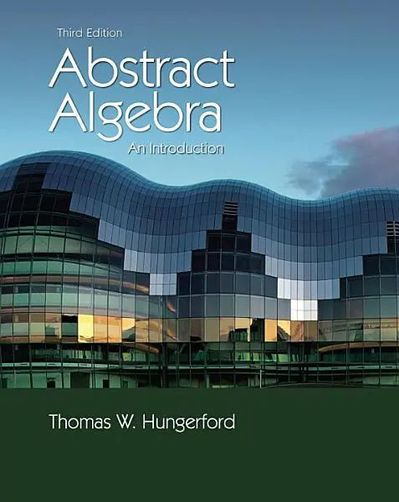
《Abstract Algebra: An Introduction》
作者:Thomas W. Hungerford
出版商:Brooks/Cole
出版年:2013
ISBN:9781111569624
适用范围:本科生
推荐强度:9
作者简介:Thomas William Hungerford(1936-2014),美国数学家,专注于代数和数学教育。他是几本被广泛使用、引用的教科书的作者或合著者,这些教科书涵盖高中到研究生水平的数学。从1963年到1980年,他在华盛顿大学任教。之后在克利夫兰州立大学任教直到2003年。从2003年到2014年,他在于圣路易斯大学工作。Hungerford对推广利用科技教授数学特别感兴趣。
书评:
This is good basic introduction to abstract algebra at the undergraduate level. It is more concrete than most such books, and is unusual in starting with rings first, making heavy use of the integers and polynomial rings as guides, and then doubling back to groups. This third edition has added a little bit of alternate treatment of some topics to provide a path starting with group theory.
The book has a strong number-theoretic flavor, with the exception of the field theory parts, which have a strong theory-of-equations flavor. I think this rings-first approach works well; although groups are simpler, the integers are much more familiar and it’s easier to go through the abstraction process.
This is not primarily a proofs book, and it recognizes the possibility that this may be the first course where students have to prove things. The book shows many examples to motivate the theorem and make it plausible, and then gives a proof. The book is well-equipped with exercises, although most of these are drill, examples, and proofs that test understanding rather than pose challenging problems or provide further developments of ideas in the body.
Very Good Feature: extensive symbol glossary and index printed on the endpapers. Very Peculiar Feature: three Technology Tips scattered through the book showing how to use a TI graphing calculator for some number theory calculations. The programs are available for download from the publisher’s web site.
Two comparable books are Herstein’s Abstract Algebra and Fraleigh’s A First Course in Abstract Algebra. Both of these follow the more traditional groups-rings-fields ordering. Herstein’s book is even more basic than Hungerford’s and is half the length. In particular, it omits Galois theory and solvable groups, although it does show the beginning of Galois theory and develops enough about field extensions to handle the classic construction problems in geometry. Fraleigh is fairly close to Hungerford in coverage, but is generally more abstract, puts more emphasis on structure and homomorphisms, has more applications, and goes a little deeper into the subject. Hungerford does a lot more hand-holding that the other two books, and sets a very leisurely pace, which accounts for much of the length of his book.
这是一本优秀的本科抽象代数入门教材。它比大多数同类教材更加具体,并且不同于其他教材,它首先介绍环,大量使用整数和多项式环来帮助读者熟悉概念,然后再折回到群。本书的第三版增加了对一些内容不同的处理方法,并提供了一个从群论开始的学习路径。
本书有很强的数论味道,除了域论部分,这部分更像是微分方程的教材。我认为这种优先介绍环论的教学方法很有效; 尽管群论更简单,但是大部分读者更熟悉整数,进而能更容易地理解抽象理论。本书不是一本只有证明的教材,并且它认识到抽象代数可能是学生第一门必须要自行完成证明的课程。因此,它展示了许多例子来说明研究某个定理的目的,使它看起来确实成立,然后再给出证明。本书有很多习题,虽然大部分都是基于已有的习题、例子和证明。这些都是为了检验读者对内容的理解,而不是向他们提出挑战性的问题,或者引发读者对相关内容进一步的思考。
本书的一大优点是书末有着详尽的索引。另一方面,不同寻常的一点是在书中有三条技术性的提示来展示如何将TI图形计算器应用于数论计算,读者们可以从出版商的网站上下载这些程序。
两本类似的教材是Herstein的Abstract Algebra与Fraleigh的A First Course in Abstract Algebra,它们都遵循以群环域顺序教授抽象代数的传统模式。Herstein的书甚至比Hungerford的书更加基础,页数也只有一半。特别地,它没有包含Galois理论和可解群的内容,即使它已经展示了Galois理论的预备知识,并且充分介绍了域扩张在几何经典构造问题中的应用。在涵盖的内容上,Fraleigh的书与Hungerford的书十分接近,但更加抽象,更强调结构与同态,有着更多与实际应用相关的内容,同时也更加深入。Hungerford的书比起其他两本要更适合初学者,解释说明更为详尽,并且大部分内容有着非常轻松的学习节奏。
点评人:Allen Stenger(Missouri Journal of Mathematical Sciences编辑,专注于数论和经典分析领域)
资料整理:孟文斌
翻译:赵旭彤

《Algebra》
作者:Thomas W. Hungerford
出版商:Springer Verlag
出版年:2003
ISBN:9780387905181
适用范围:研究生一年级
推荐强度:9
作者简介:Thomas William Hungerford(1936-2014),美国数学家,专注于代数和数学教育。他是几本被广泛使用、引用的教科书的作者或合著者,这些教科书涵盖高中到研究生水平的数学。从1963年到1980年,他在华盛顿大学任教。之后在克利夫兰州立大学任教直到2003年。从2003年到2014年,他在于圣路易斯大学工作。Hungerford对推广利用科技教授数学特别感兴趣。
书评:
This is a text for a first-year graduate course in abstract algebra. It covers all the standard topics and has more than enough material for a year course. It is self-contained, but assumes the student has already had an undergraduate modern algebra course. The present volume is a 2003 corrected reprint of the 1974 Holt, Rinehart and Winston volume.
A comparable book is Dummit & Foote’s Abstract Algebra. Despite being thirty years newer and having about twice as many pages, this book has generally the same coverage and approach. Dummit and Foote do have some newer topics such as Gröbner bases. Their greater length comes primarily from a larger number of worked examples (that are also worked out in more detail), more exercises (both books are well-supplied with exercises), and from being more chatty (Hungerford follows the traditional Theorem-Proof exposition, with occasional road signs to tell us where we are going).
Hungerford’s newer book Abstract Algebra: An Introduction is a very different book. It is a good undergraduate introduction to the present book, but only overlaps it by about 50%. The newer book has a much larger number of applications, many of them recent.
这是一本为一年级研究生准备的抽象代数教材,涵盖了大部分同类教材涉及的内容,足够一年的课程使用。它自成一体,但假设学生已修习过本科生级别的近世代数课程。这一版是于2003年对1974年Holt, Rinehart和Winston版本的修订再版。
与之相近的教材是Dummit和Foote的Abstract Algebra. 尽管它的出版时间晚了三十年,页数是Hungerford的书的两倍,它们的知识覆盖面与教学方法却大体相同。Dummit和Foote的书确实有一些新内容,例如Gröbner基。其更长的篇幅主要来自于大量的例题(都伴有详细的叙述),更多习题(两本书都提供了高质量的习题),以及更多解释说明(Hungerford 的书遵循传统的定理证明方法,偶尔才会有提示性的语句来表明意图)。
Hungerford的新书Abstract Algebra: An Introduction与本书有天差地别。它是一本优秀的笼统介绍抽象代数的本科生教材,大概只涵盖了本书50%的内容。此外,那本新书也有很多的现代实例。
点评人:Allen Stenger(Missouri Journal of Mathematical Sciences编辑,专注于数论和经典分析领域)
资料整理:孟文斌
翻译:赵旭彤
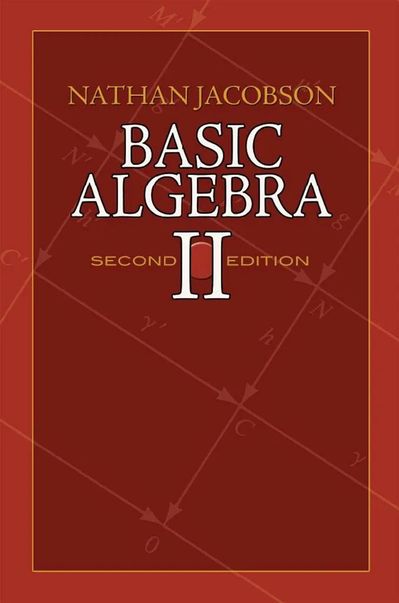
《Basic Algebra Ⅱ》
作者:Nathan Jacobson
出版商:Dover Publications
出版年:2009
ISBN:9780486471877
适用范围:本科生
推荐强度:8
作者简介:Nathan Jacobson(1910-1999),美国科学家,1934年于普林斯顿大学获得博士学位。他曾在多所大学任教研究,最终于1947年开始在耶鲁大学任教直至退休。他是美国国家科学院和美国艺术与科学学院的成员。从1971年到1973年,他担任美国数学学会的主席,并于1998年被授予最高荣誉——Leroy P. Steele终身成就奖。1972年至1974年,他还担任国际数学联合会副主席。
书评:
This book is a sequel to the author’s Basic Algebra I, but it is not a continuation: it treats a completely new set of topics, at a much higher level of abstraction. It is “basic” only in the sense that the material studied here is the basis for getting started with modern abstract algebra. The present volume is an unaltered reprint of the 1989 second edition.
The first chapter covers categories, and most of the rest of the book takes a category-theoretic approach. The pace here is more leisurely than it was in the first volume, and the book does not go into great depth on any topic. For example, the chapter on valuations does not go much beyond the ramification index, Krasner’s Lemma, and Hensel’s Lemma.
The book does have a large number of exercises, of varying levels of difficulty, and most of these explore further developments and are not simple applications of the text material.The great weakness of the book is that it is relentlessly abstract: there are almost no concrete examples of the abstract structures that are being studied. Each chapter is careful to credit the areas of mathematics from which it is abstracted (usually these are number theory and algebraic geometry), but we never see any applications back to the source subjects.
这本书是同一作者的Basic Algebra I的续篇,但它不仅仅是续篇:它在更加抽象的层次上处理了一系列全新的内容。它是“基本的”,其含义是本书的内容是现代抽象代数的基础。
第一章包括范畴论,而本书的其余部分也大多应用范畴论的方法。本书的风格比第一卷要更加悠闲,并没有深入探讨某一话题。例如,关于赋值论的章节并没有超出分歧指数、Krasner引理和Hensel引理的范围。
本书有大量的习题,难度各不相同,其中大部分是对正文的延伸与探索,而不是简单应用。这本书最大的缺点是它非常抽象:几乎没有具体例子。书中一些内容是从特定领域(通常是数论和代数几何)抽象而来,每一章都强调了它们的重要性,但是我们却从来没有看到这些内容在原始学科中的应用。
点评人:Allen Stenger(Missouri Journal of Mathematical Sciences编辑,专注于数论和经典分析领域)
资料整理:孟文斌
翻译:赵旭彤
